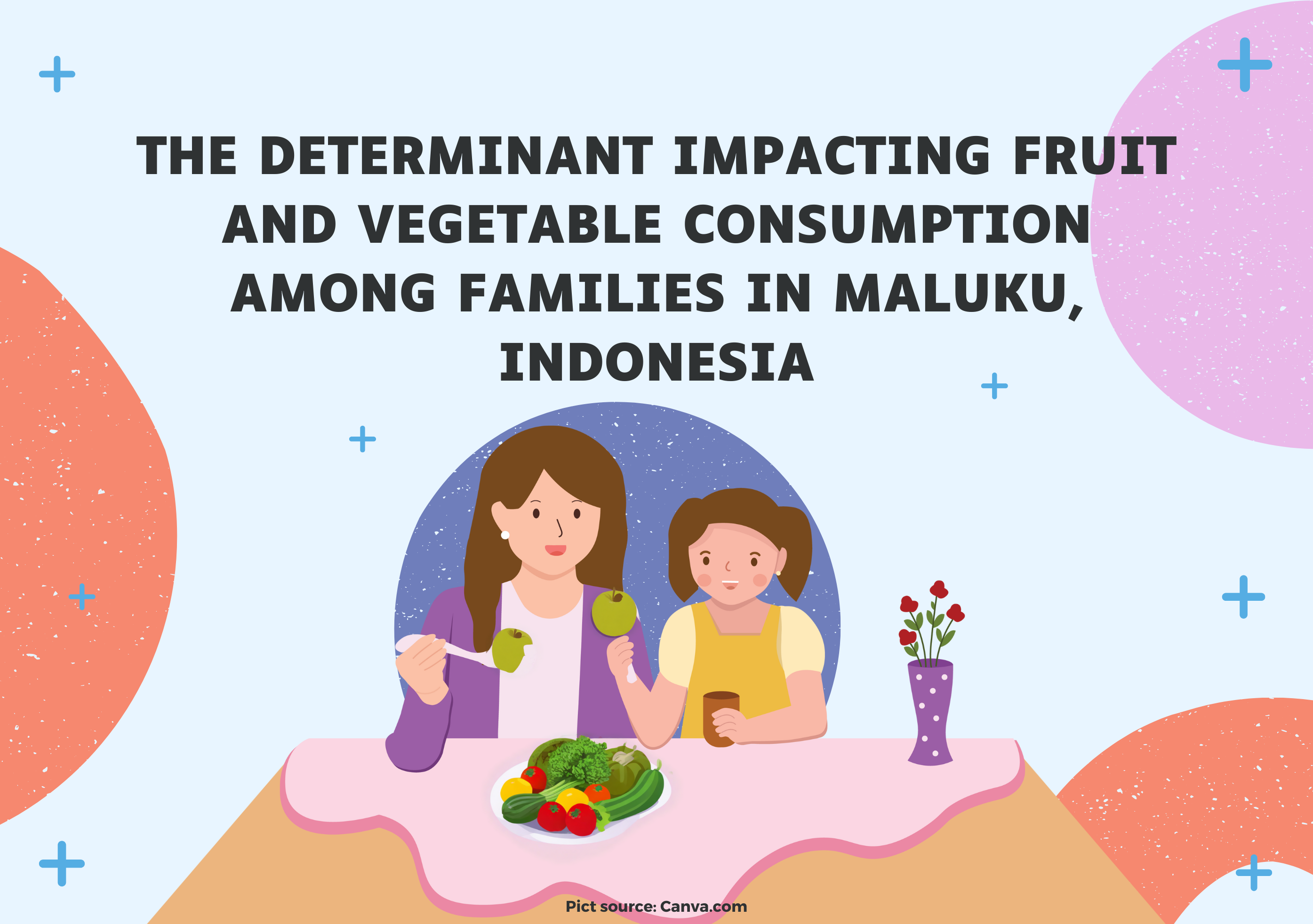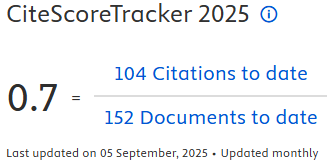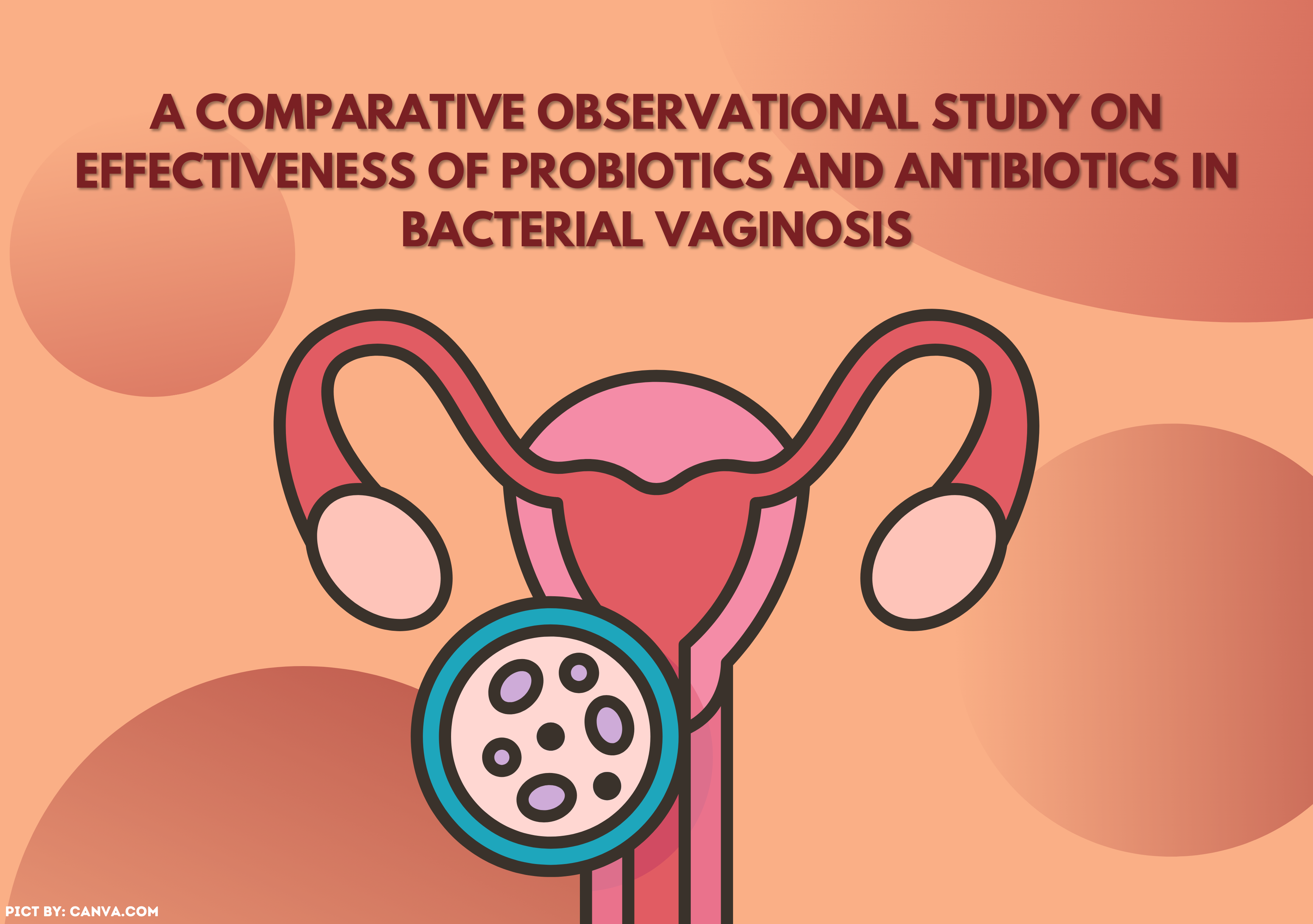THE DETERMINANT IMPACTING FRUIT AND VEGETABLE CONSUMPTION AMONG FAMILIES IN MALUKU, INDONESIA

Downloads
Introduction: Consuming a minimum of 400 g of fruits and vegetables (FV) daily fulfills nutritional needs and diminishes the possibility of getting specific non-communicable diseases. In low or middle-income countries, about 80% of people consume fruits and vegetables below the WHO's recommendations, including Indonesia, where 93.6% of the population does so. In Indonesia, the annual per capita consumption of FV is only 35 kg; however, in Maluku, it is far lower at 7.78 kg per capita annually, below the Food and Agriculture Organization (FAO)’s objective of 75 kg per year. Aims: This study aims to identify the determinants that impact family behavior regarding FV consumption. Methods: This study took a cross-sectional approach. The purposive sampling chose a total of 398 families. The study employed a questionnaire that has passed validity and reliability tests, with Cronbach alpha >0.8. Results: The findings revealed that 192 (48%) respondents had enough knowledge, 253 (63.2%) had good access to fruits and vegetables, and 198 (49.5%) demonstrated good behavior. Furthermore, the chi-square test revealed that knowledge and family consumption of fruits and vegetables are correlated (p-value 0.001) as well as between FV availability and family consumption behavior (p-value 0.036). Conclusions: The study's findings serve as a road map for local governments, health institutions, and related parties seeking to ensure the availability of fruits and vegetables to meet the community's consumption demands. It also focuses on family-centered education to enhance FV consumption behavior.
Adler, N.E., Glymour, M.M. and Fielding, J. (2016) ‘Addressing social determinants of health and health inequalities’, JAMA - Journal of the American Medical Association. American Medical Association, pp. 1641–1642. Available at: https://doi.org/10.1001/jama.2016.14058.
Aune, D. et al. (2017) ‘FV intake and the risk of cardiovascular disease, total cancer and all-cause mortality-a systematic review and dose-response meta-analysis of prospective studies.’, International Journal of Epidemiology [Preprint]. Available at: https://doi.org/10.1093/ije/dyw319.
Bayram, T. and Donchin, M. (2019) ‘Determinants of health behavior inequalities: a cross-sectional study from Israel’, Health Promotion International, 34(5), pp. 941–952. Available at: https://doi.org/10.1093/heapro/day054.
Black, C. et al. (2014) ‘Dietary inequalities: what is the evidence for the effect of the neighborhood food environment?’, Health & Place [Preprint]. Available at: https://doi.org/10.1016/j.healthplace.2013.09.015.
Buil‐Cosiales, P. et al. (2016) ‘Association between dietary fibre intake and fruit, vegetable or whole-grain consumption and the risk of CVD: results from the PREvención con DIeta MEDiterránea (PREDIMED) trial.’, British Journal of Nutrition [Preprint]. Available at: https://doi.org/10.1017/s0007114516002099.
Darmon, N. et al. (2015) ‘Contribution of food prices and diet cost to socioeconomic disparities in diet quality and health: a systematic review and analysis.’, Nutrition Reviews [Preprint]. Available at: https://doi.org/10.1093/nutrit/nuv027.
Faber, M. et al. (2013) ‘Availability of, access to and consumption of fruits and vegetables in a peri‐urban area in KwaZulu‐Natal, South Africa’, Maternal and Child Nutrition [Preprint]. Available at: https://doi.org/10.1111/j.1740-8709.2011.00372.x.
Food Security Bureau of Maluku Provincial Government (2021) ‘Penyusunan Laporan Kinerja Instansi Pemerintah (LKIP)’.
Frank, S.M. et al. (2019) ‘Consumption of Fruits and Vegetables Among Individuals 15 Years and Older in 28 Low- and Middle-Income Countries’, The Journal of Nutrition, 149(7), pp. 1252–1259. Available at: https://doi.org/10.1093/JN/NXZ040
Hernández-Vásquez, A. et al. (2022) ‘Socioeconomic inequalities in the consumption of FVs in Peru between 2014 and 2019.’, Public Health Nutrition [Preprint]. Available at: https://doi.org/10.1017/s1368980022001860.
Holdsworth, M. and Landais, E. (2019) ‘Urban food environments in Africa: implications for policy and research’, Proceedings of the Nutrition Society, 78(4), pp. 513–525. Available at: https://doi.org/10.1017/S0029665118002938.
Hong, M., De Gagne, J.C. and Shin, H. (2018) ‘Social networks, health promoting-behavior, and health-related quality of life in older Korean adults’, Nursing & Health Sciences, 20(1), pp. 79–88. Available at: https://doi.org/10.1111/nhs.12390.
Hosseini, B. et al. (2017) ‘Effects of FV Consumption on Risk of Asthma, Wheezing and Immune Responses: A Systematic Review and Meta-Analysis’, Nutrients [Preprint]. Available at: https://doi.org/10.3390/nu9040341.
Imamura, F. et al. (2015) ‘Dietary quality among men and women in 187 countries in 1990 and 2010: a systematic assessment’, The Lancet Global Health [Preprint]. Available at: https://doi.org/10.1016/s2214-109x(14)70381-x.
Indonesian Data (2023) List of Regency Minimun Wages in 2023 in Maluku Province (Daftar Lengkap UMK 2023 di Maluku) - Dataindonesia.id.
Kabwama, S.N. et al. (2019) ‘Low consumption of fruits and vegetables among adults in Uganda: findings from a countrywide cross-sectional survey’, Archives of public health = Archives belges de sante publique, 77(1). Available at: https://doi.org/10.1186/S13690-019-0332-6.
Kalmpourtzidou, A., Eilander, A. and Talsma, E.F. (2020) ‘Global Vegetable Intake and Supply Compared to Recommendations: A Systematic Review’, Nutrients 2020, Vol. 12, Page 1558, 12(6), p. 1558. Available at: https://doi.org/10.3390/NU12061558.
Karim, N. et al. (2017) ‘Sociodemographic Determinants of Low FV Consumption Among Bangladeshi Adults: Results From WHO-STEPS Survey 2010.’, Asia-Pacific Journal of Public Health [Preprint]. Available at: https://doi.org/10.1177/1010539517699059.
Kaur, S. (2023) ‘Barriers to consumption of fruits and vegetables and strategies to overcome them in low- and middle-income countries: a narrative review’, Nutrition Research Reviews, 36(2), pp. 420–447. Available at: https://doi.org/10.1017/S0954422422000166.
Ma, Y. et al. (2021) ‘Exploring Pathways of Socioeconomic Inequity in Vegetable Expenditure Among Consumers Participating in a Grocery Loyalty Program in Quebec, Canada, 2015-2017.’, Frontiers in Public Health [Preprint]. Available at: https://doi.org/10.3389/fpubh.2021.634372.
Mason-D’Croz, D. et al. (2019) ‘Gaps between FV production, demand, and recommended consumption at global and national levels: an integrated modelling study.’, The Lancet Planetary Health [Preprint]. Available at: https://doi.org/10.1016/s2542-5196(19)30095-6.
Mason-D’Croz, D. et al. (2019) ‘Gaps between FV production, demand, and recommended consumption at global and national levels: an integrated modelling study.’, The Lancet Planetary Health [Preprint]. Available at: https://doi.org/10.1016/s2542-5196(19)30095-6.
Mhurchú, C.N. et al. (2013) ‘Monitoring the availability of healthy and unhealthy foods and non-alcoholic beverages in community and consumer retail food environments globally.’, Obesity Reviews [Preprint]. Available at: https://doi.org/10.1111/obr.12080.
Miller, V. et al. (2016) ‘Availability, affordability, and consumption of fruits and vegetables in 18 countries across income levels: findings from the Prospective Urban Rural Epidemiology (PURE) study’, The Lancet Global Health [Preprint]. Available at: https://doi.org/10.1016/s2214-109x(16)30186-3.
Miller, V. et al. (2017) ‘Fruit, vegetable, and legume intake, and cardiovascular disease and deaths in 18 countries (PURE): a prospective cohort study’, The Lancet [Preprint]. Available at: https://doi.org/10.1016/s0140-6736(17)32253-5.
Minister of Health of The Republic Indonesia (2018) ‘Basic Health Research 2018 (Riset Kesehatan dasar tahun 2018)’.
Msambichaka, B. et al. (2018) ‘Insufficient FV Intake in a Low- and Middle-Income Setting: A Population-Based Survey in Semi-Urban Tanzania’, Nutrients [Preprint]. Available at: https://doi.org/10.3390/nu10020222.
Nour, M. et al. (2017) ‘The FV intake of young Australian adults: a population perspective’, Public Health Nutrition, 20(14), pp. 2499–2512. Available at: https://doi.org/10.1017/S1368980017001124.
Nursalam, N.I.D.N. (2016) Metodologi penelitian ilmu keperawatan. Salimba Medika.
Ong, J.X. et al. (2017) ‘Relationship between the home environment and FV consumption in children aged 6–12 years: a systematic review’, Public Health Nutrition [Preprint]. Available at: https://doi.org/10.1017/s1368980016002883.
Pakpahan, M. and Ayubi, D. (2022) ‘Factors Related to Family Health Behavior in Samosir District: A Mix-Methods Study’, Open Access Macedonian Journal of Medical Sciences [Preprint]. Available at: https://doi.org/10.3889/oamjms.2022.10757.
Rekhy, R. et al. (2014) ‘Promoting consumption of FVs for better health. Have campaigns delivered on the goals’, Appetite [Preprint]. Available at: https://doi.org/10.1016/j.appet.2014.04.012
Rosi, A. et al. (2019) ‘Dietary habits of adolescents living in North America, Europe or Oceania: A review on fruit, vegetable and legume consumption, sodium intake, and adherence to the Mediterranean Diet’, Nutrition, Metabolism and Cardiovascular Diseases, 29(6), pp. 544–560. Available at: https://doi.org/10.1016/J.NUMECD.2019.03.003.
Stea, T.H. et al. (2020) ‘FV consumption in Europe according to gender, educational attainment and regional affiliation-A cross-sectional study in 21 European countries.’, PLOS ONE [Preprint]. Available at: https://doi.org/10.1371/journal.pone.0232521.
Surendran, S. et al. (2020) ‘Characterising the FV environment of peri-urban Hyderabad, India’, Global Food Security, 24, p. 100343. Available at: https://doi.org/10.1016/J.GFS.2019.100343.
Sun, L. et al. (2021) ‘Fruit consumption and multiple health outcomes: An umbrella review’, Trends in Food Science and Technology [Preprint]. Available at: https://doi.org/10.1016/j.tifs.2021.09.023.
The Central Bureau of Statistics (2018) Rata-rata Konsumsi Protein Perkapita Sehari di Provinsi Maluku (Gram), 2020-2022.
Ursulica, T.E. (2016) ‘The Relationship between Health Care Needs and Accessibility to Health Care Services in Botosani County- Romania’, Procedia Environmental Sciences, 32, pp. 300–310. Available at: https://doi.org/10.1016/j.proenv.2016.03.035.
World Health Organization. (2023) Increasing FV consumption to reduce the risk of noncommunicable diseases.
Yahia, E.M., García-Solís, P. and MaldonadoCelis, M.E. (2019) ‘Contribution of Fruits and Vegetables to Human Nutrition and Health’, Postharvest Physiology and Biochemistry of Fruits and Vegetables, pp. 19–45. Available at: https://doi.org/10.1016/B978-0-12-813278-4.00002-6.
Yang, Y. et al. (2020) ‘Association between diet-related knowledge, attitudes, behaviors, and self-rated health in Chinese adult residents: a population-based study.’, BMC Public Health [Preprint]. Available at: https://doi.org/10.1186/s1288
Copyright (c) 2025 The Indonesian Journal of Public Health

This work is licensed under a Creative Commons Attribution-NonCommercial-ShareAlike 4.0 International License.
- The authors agree to transfer the transfer copyright of the article to The Indonesian Journal of Public Health effective if and when the paper is accepted for publication.
- Authors and other parties are bound to the Creative Commons Attribution-NonCommercial-ShareAlike 4.0 International License for the published articles, legal formal aspect of journal publication accessibility refers to Creative Commons Attribution-NonCommercial-ShareAlike 4.0 International License (CC BY-NC-SA), implies that:
- Attribution ” You must give appropriate credit, provide a link to the license, and indicate if changes were made. You may do so in any reasonable manner, but not in any way that suggests the licensor endorses you or your use.
- NonCommercial ” You may not use the material for commercial purposes.
- ShareAlike ” If you remix, transform, or build upon the material, you must distribute your contributions under the same license as the original.































